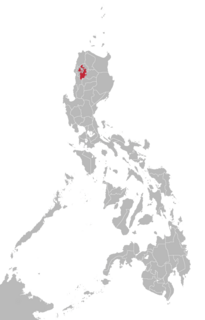Related Research Articles
Most languages of Europe belong to the Indo-European language family. Out of a total European population of 744 million as of 2018, some 94% are native speakers of an Indo-European language; within Indo-European, the three largest phyla are Romance, Germanic, and Slavic with more than 200 million speakers each, between them accounting for close to 90% of Europeans. Smaller phyla of Indo-European found in Europe include Hellenic, Baltic, Albanian, Celtic and Indo-Aryan.
Ethnologue: Languages of the World is an annual reference publication in print and online that provides statistics and other information on the living languages of the world. It was first issued in 1951, and is now published annually by SIL International, a U.S.-based, worldwide, Christian non-profit organization. SIL's main purpose is to study, develop and document languages for religious purposes and to promote literacy.
Luhya is a Bantu language of western Kenya.
Wetarese is an Austronesian language of Wetar, an island in the south Maluku, Indonesia, and of the nearby islands Liran and Atauro, the latter island located in East Timor north of Dili.
The Wanda are a Bantu ethno-linguistic group based in Mbeya Region and southern Rukwa Region of Tanzania. The Wanda population was estimated to be 24,000 in 1987, having increased from 5,745 in 1931, 7,677 in 1948, and 9,477 in 1957.

Cameroon is home to at least 250 languages. However, some accounts report around 600 languages. These include 55 Afro-Asiatic languages, two Nilo-Saharan languages, four Ubangian languages, and 169 Niger–Congo languages. This latter group comprises one Senegambian language (Fulfulde), 28 Adamawa languages, and 142 Benue–Congo languages . French and English are official languages, a heritage of Cameroon's colonial past as a colony of both France and the United Kingdom from 1916 to 1960. Eight out of the ten regions of Cameroon are primarily francophone, representing 83% of the country's population, and two are anglophone, representing 17%. The anglophone proportion of the country is in constant regression, having decreased from 21% in 1976 to 20% in 1987 and to 17% in 2005, and is estimated at 16% in 2015.
The Tharu or Tharuhat languages are any of the Indo-Aryan languages spoken by the Tharu people of the Terai region in Nepal, and neighboring regions of Uttarakhand, Uttar Pradesh and Bihar in India.

Sámi languages, in English also rendered as Sami and Saami, are a group of Uralic languages spoken by the Sámi people in Northern Europe. There are, depending on the nature and terms of division, ten or more Sami languages. Several spellings have been used for the Sámi languages, including Sámi, Sami, Saami, Saame, Sámic, Samic and Saamic, as well as the exonyms Lappish and Lappic. The last two, along with the term Lapp, are now often considered pejorative.
Kayan is a dialect cluster spoken by the Kayan people of Borneo. It is a cluster of closely related dialects with limited mutual intelligibility, and is itself part of the Kayan-Murik group of Austronesian languages.
Kulisusu is an Austronesian language of Southeast Sulawesi, Indonesia. It is part of a dialect chain with two minor languages, Koroni and Taloki.
Lamaholot, also known as Solor or Solorese, is a Central Malayo-Polynesian dialect cluster of Flores, Indonesia. The varieties may not be all mutually intelligible; Keraf (1978) reports that there are 18 languages under the name.

Itneg is a South-Central Cordilleran dialect continuum found in the island of Luzon, Philippines. This language and Ilocano are spoken by the Itneg people in Abra.
Spurious languages are languages that have been reported as existing in reputable works, while other research has reported that the language in question did not exist. Some spurious languages have been proven to not exist. Others have very little evidence supporting their existence, and have been dismissed in later scholarship. Others still are of uncertain existence due to limited research.
Kimaragang (Marigang), Tobilung, and Rungus are varieties of a single Austronesian language of Sabah, Malaysia. The three varieties share moderate mutual intelligibility. Children are not learning it well in some areas.
Highland Chinantec is a Chinantecan language of Mexico, spoken in Comaltepec, San Juan Quiotepec, and surrounding towns in northern Oaxaca. It has a complex system of tone and vowel length compared to other Chinantec languages. The two principal varieties, Quiotepec and Comaltepec, have marginal mutual intelligibility. Yolox Chinantec is somewhat less divergent.

The Bengali–Assamese languages is a grouping of several languages. This group belongs to the Eastern zone of Indo-Aryan languages. The languages in this group as per Glottolog includes Assamese, Bengali, Bishnupriya, Chakma, Chittagonian, Hajong, Kharia Thar, Kurmukar, Lodhi, Mal Paharia, Noakhailla, Rajbangshi, Rohingya, Sylheti, Tangchangya and Surjapuri.
Masela (Marsela) is the language of Marsela Island in southern Maluku, Indonesia. Regional varieties are distinct; Ethnologue counts it as three languages.
References
- ↑ Wanda at Ethnologue (18th ed., 2015)
- ↑ Jouni Filip Maho, 2009. New Updated Guthrie List Online
- ↑ Endangered Languages Project data for Sichela.
- ↑ "Wanda". Ethnologue. Retrieved 2019-07-08.